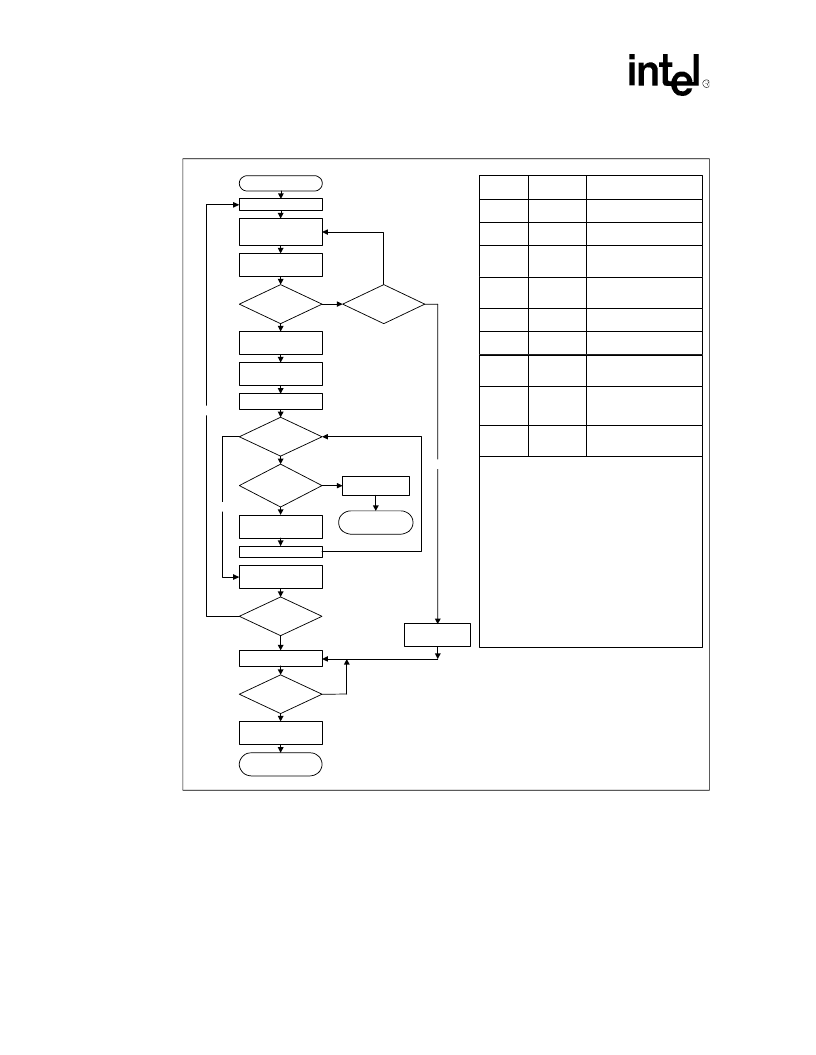- 您現(xiàn)在的位置:買賣IC網(wǎng) > PDF目錄371435 > 28F128 (Intel Corp.) 3 Volt Intel StrataFlash Memory PDF資料下載
參數(shù)資料
| 型號: | 28F128 |
| 廠商: | Intel Corp. |
| 英文描述: | 3 Volt Intel StrataFlash Memory |
| 中文描述: | 3伏特英特爾StrataFlash存儲器 |
| 文件頁數(shù): | 36/58頁 |
| 文件大小: | 380K |
| 代理商: | 28F128 |
第1頁第2頁第3頁第4頁第5頁第6頁第7頁第8頁第9頁第10頁第11頁第12頁第13頁第14頁第15頁第16頁第17頁第18頁第19頁第20頁第21頁第22頁第23頁第24頁第25頁第26頁第27頁第28頁第29頁第30頁第31頁第32頁第33頁第34頁第35頁當(dāng)前第36頁第37頁第38頁第39頁第40頁第41頁第42頁第43頁第44頁第45頁第46頁第47頁第48頁第49頁第50頁第51頁第52頁第53頁第54頁第55頁第56頁第57頁第58頁

28F128J3A, 28F640J3A, 28F320J3A
30
Preliminary
0606_07A
Figure 7. Write to Buffer Flowchart
Start
Write Word or Byte
Count, Block Address
Write Buffer Data,
Start Address
X = 0
X = X + 1
Write Next Buffer Data,
Device Address
Abort Write to
Buffer Command
Check
X = N
Another Write to
Buffer
Read Status Register
SR.7 =
Programming
Complete
Read Extended
Status Register
XSR.7 =
1
No
Yes
No
No
1
Write to Buffer
Aborted
Yes
No
Yes
Full Status
Check if Desired
Program Buffer to Flash
Confirm D0H
Issue Write to Buffer
Command E8H, Block
Address
Write to Another
Block Address
Write to
Buffer Time-Out
0
Set Time-Out
Issue Read
Status Command
Yes
Bus
Operation
Command
Comments
Write
Write to Buffer
Data = E8H
Block Address
Read
XSR. 7 = Valid
Addr = Block Address
Standby
Check XSR. 7
1 = Write Buffer Available
0 = Write Buffer Not Available
Write
(Note 1, 2)
Data = N = Word/Byte Count
N = 0 Corresponds to Count = 1
Addr = Block Address
Write
(Note 3, 4)
Data = Write Buffer Data
Addr = Device Start Address
Write
(Note 5, 6)
Data = Write Buffer Data
Addr = Device Address
Write
Program Buffer
to Flash
Confirm
Data = D0H
Addr = Block Address
Read
(Note 7)
Status Register Data with the
Device Enabled, OE# Low
Updates SR
Addr = Block Address
Standby
Check SR.7
1 = WSM Ready
0 = WSM Busy
1. Byte or word count values on DQ
- DQ
are loaded into the
count register. Count ranges on this device for byte mode are N
= 00H to 1FH and for word mode are N = 0000H to 000FH.
2. The device now outputs the status register when read (XSR is
no longer available).
3. Write Buffer contents will be programmed at the device start
address or destination flash address.
4. Align the start address on a Write Buffer boundary for
maximum programming performance (i.e., A
4
- A
0
of the start
address = 0).
5. The device aborts the Write to Buffer command if the current
address is outside of the original block address.
6. The status register indicates an "improper command
sequence" if the Write to Buffer command is aborted. Follow this
with a Clear Status Register command.
7. Toggling OE# (low to high to low) updates the status register.
This can be done in place of issuing the Read Status Register
command.
Full status check can be done after all erase and write sequences
complete. Write FFH after the last operation to reset the device to
read array mode.
0
1
相關(guān)PDF資料 |
PDF描述 |
|---|---|
| 28F1602C3 | 3 Volt Advanced+ Stacked Chip Scale Package Memory(3V閃速存儲器和靜態(tài)存儲器) |
| 28F3204C3 | 3 V Advanced+ Stacked Chip Scale Package Memory(3V高級堆芯片封裝存儲器) |
| 28F1604C3 | 3 Volt Advanced+ Stacked Chip Scale Package Memory(3V閃速存儲器和靜態(tài)存儲器) |
| 28F160C18 | 1.8V Advanced+ Boot Block Flash Memory(1.8V高級引導(dǎo)塊閃速存儲器) |
| 28F160C2 | 2.4V Advanced+ Boot Block Flash Memory(2.4V高級引導(dǎo)塊閃速存儲器) |
相關(guān)代理商/技術(shù)參數(shù) |
參數(shù)描述 |
|---|---|
| 28F128J3A | 制造商:INTEL 制造商全稱:Intel Corporation 功能描述:3 Volt Intel StrataFlash Memory |
| 28F128J3A150 | 制造商: 功能描述: 制造商:INTELC 功能描述: 制造商:undefined 功能描述: |
| 28F128J3A-150 | 制造商: 功能描述: 制造商:undefined 功能描述: |
| 28F128J3D75 | 制造商: 功能描述: 制造商:Intel 功能描述: |
| 28F128J3FS-12ET | 制造商: 功能描述: 制造商:undefined 功能描述: |
發(fā)布緊急采購,3分鐘左右您將得到回復(fù)。